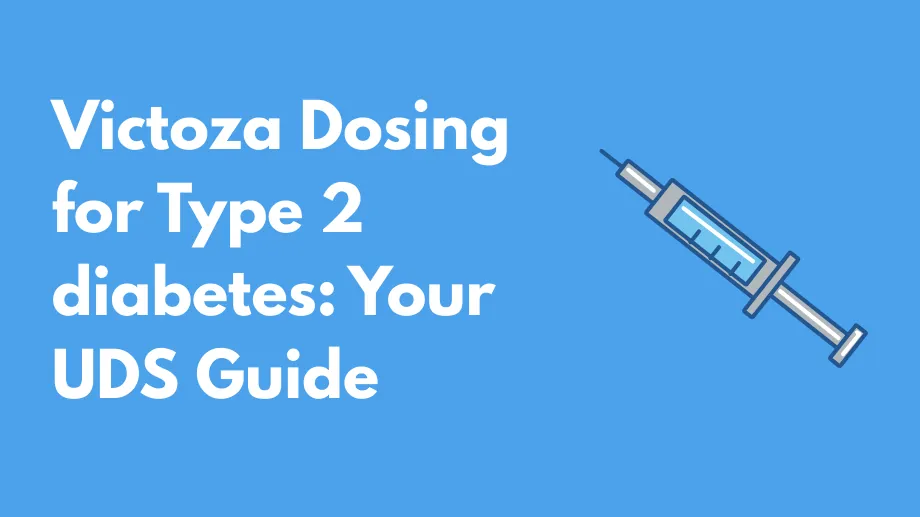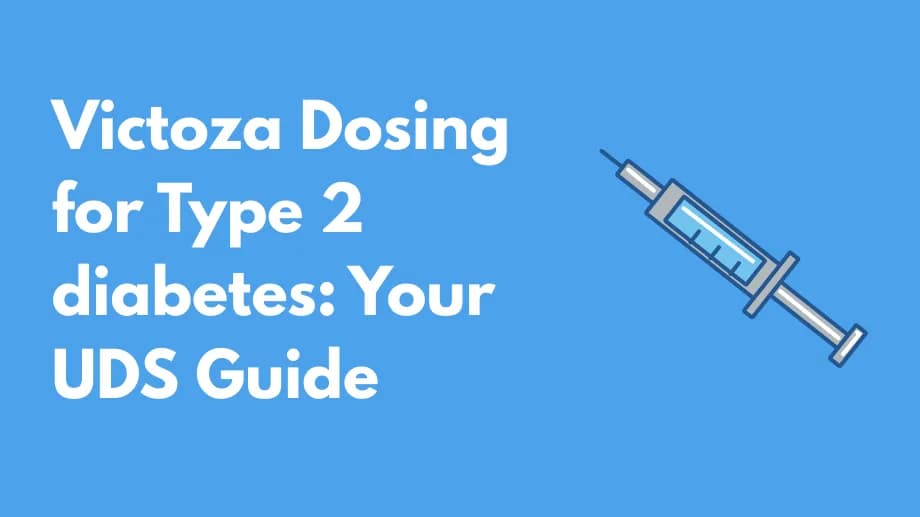Victoza Dosing for Type 2 diabetes

Victoza Dosing for Type 2 Diabetes: Your UDS Guide
Victoza (liraglutide) is a non‑insulin, injectable Type 2 diabetes mellitus medication. It comes as a multi‑dose, prefilled pen that you inject under the skin (subcutaneous) of your stomach, thigh, or upper arm.
You will typically start with a low dose of Victoza and then gradually increase it over a few weeks until you find the lowest effective maintenance dose. This is done to reduce your risk of side effects like nausea, diarrhea, and headache. In this guide, we will go over a typical Victoza titration schedule for adults and children 10 years of age and older.
Recommended Victoza Dosage Schedule for Adults
- Week 1: 0.6 mg injected once daily
- Week 2: 1.2 mg injected once daily
- Week 3 and beyond: After at least one week at 1.2 mg, your provider may increase to 1.8 mg once daily (maximum dose)
Recommended Victoza Dosage Schedule for Children (≥10 Years)
- Week 1: 0.6 mg injected once daily
- Weeks 2 and beyond: Provider may increase to 1.2 mg once daily, then up to 1.8 mg once daily after at least one week at 1.2 mg
Missed Dose Instructions
If you miss a dose of Victoza, skip the missed dose and take your next dose at its regular time. Do not double up to catch up. If you miss three or more doses in a row, call your healthcare provider for guidance; they may have you restart at the lowest dose.
Storage Instructions
- Store new, unused pens refrigerated at 36–46 °F (2–8 °C). Do not freeze.
- After first use, store at room temperature (59–86 °F / 15–30 °C) or refrigerated (36–46 °F / 2–8 °C) for up to 30 days.
- Discard pens exposed above 86 °F (30 °C). Keep cap on to protect from light and heat.
What Victoza Is Used for
- Improve blood sugar control in adults and children ≥10 years with Type 2 diabetes, alongside diet and exercise
- Reduce risk of serious cardiovascular events (heart attack, stroke) in adults with Type 2 diabetes and established heart disease
Common Side Effects
The most common side effects in clinical trials include:
- Diarrhea
- Nausea
- Vomiting
- Constipation
- Injection site reactions
- Headache
- Loss of appetite
- Weight loss
- Common cold symptoms
- Indigestion
- Dizziness
Serious Side Effects
- Severe allergic reactions (hives, swelling, difficulty breathing)
- Pancreatitis (inflammation of the pancreas)
- Increased risk of thyroid tumors (medullary thyroid carcinoma)
- Gallbladder problems (gallstones, cholecystitis)
- Hypoglycemia when used with other diabetes medications
- Kidney problems
These are not all possible side effects. Contact your healthcare provider for medical advice and report any adverse effects to the FDA at 1‑800‑FDA‑1088 or www.fda.gov/medwatch.
Boxed Warning
Victoza carries a boxed warning for potential thyroid tumors observed in animal studies, including medullary thyroid carcinoma and multiple endocrine neoplasia syndrome type 2. Do not use if you have a personal or family history of these conditions.
Additional Considerations
Inform your provider of other medical conditions such as alcohol use disorder, gallbladder disease, depression, gastroparesis, kidney disease, Type 1 diabetes, pancreatitis, or diabetic ketoacidosis before starting Victoza.
Sources
- Victoza – liraglutide injection [package insert]. Novo Nordisk. Last updated 11/2024. Accessed May 9, 2025.
